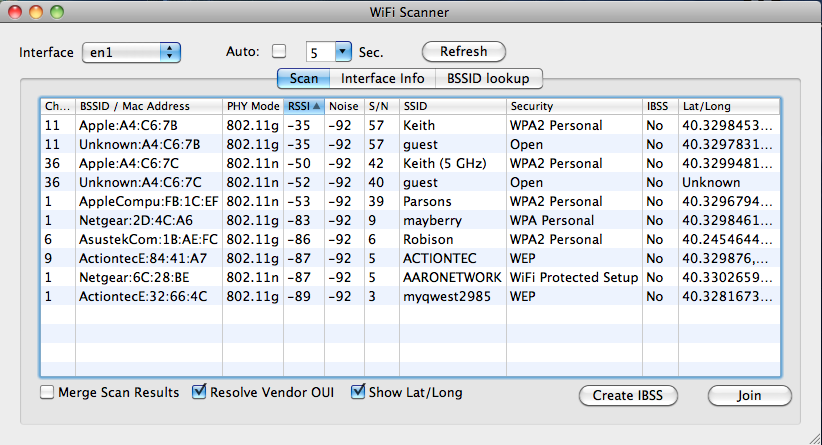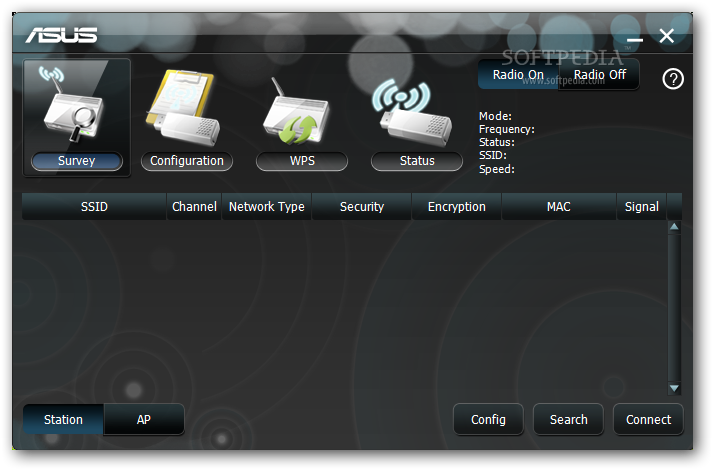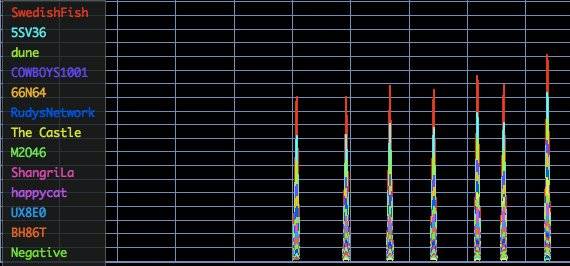- Wifi Channel Scanner Mac
- Wifi Analyzer Mac Free
- Wifi Scanner Windows
- Wireless Scanner Mac Free
- Wifi Scanner For Mac Free
KisMAC - Free & Open-Source WiFi Scanner for Mac. KisMAC is a free and open-source wireless network discovery tool for macOS X/11. It helps you find all kinds of Wi-Fi networks, even the hidden or closed Wi-Fi, IP addresses and signal strength. KisMAC supports cards like Apple’s AirPort, AirPort Extreme, and third-party cards. Changing your WiFi channel can be the difference between a stable connection for your devices, and a connection that makes you want to pull your hair out. Mac OS X Yosemite already has a WiFi scanner to help you find the best WiFi channel, but like in OS X Mavericks, Apple have made it sort of tricky to find. Download KisMAC and install it on your Mac. Go to Preferences - Drivers and select the WiFi driver device to be used. Click on Add to use the selected driver. Click Start Scan and provide KisMAC with your administrator’s password. You will be presented with a list of wireless networks that are within range and the type of security they are.
Use WiFi analyzer tools for everything NetSpot – WiFi analyzer app for macOS offers the most visual and convenient heat maps and more. WiFi Scanner – WiFi analyzer app for Mac that also detects access points and clients in ad-hoc mode in case the SSID is. IStumbler for Mac – WiFi analyzer app for.
Connect to Wi-Fi
- Monitor and control application access to network and disks. Remotely control Macs; admin component. VPN client for everyone. Easily access your remote systems. Connect to Windows machines. Set up and manage your Wi-Fi network and AirPort base stations. Wireless survey tool.
- Download and install the best free apps for Wireless Networking Software on Windows, Mac, iOS, and Android from CNET Download.com, your trusted source for the top software picks.
- A wide number of WiFi Cracker tools are being introduced nowadays due to the rise in demands of the customers. These tools support all the various platforms and you can search online to find out the best one for your device. Install the tool in your device to start hacking wireless networks. Wi-Fi Crack for Mac.
You can use the Wi-Fi menu to quickly connect to a nearby wireless network.
- Click the Wi-Fi icon ( or ) in the menu bar.
- If Wi-Fi is off, choose 'Turn Wi-Fi on.'
- Select a nearby Wi-Fi network from the list.
If you don't see your network listed, make sure it's nearby and that others can connect to it. It could also be a 'hidden' network. You can connect to a hidden network by choosing 'Join other network' and entering the name of the network you're trying to use.
The strength of each nearby network is shown next to its name. More darkened bars indicate a stronger network connection.

Enter your password
Networks that have a lock icon next to their name require a password. After you select your network, enter the network password when you're prompted. If you don't know the network password, check with the owner of the Wi-Fi network you're trying to join.
Use a cellular device as your Wi-Fi connection
Depending on your cellular plan, your iPhone or iPad with cellular can share its Internet connection with your Mac. When your iOS device is configured properly and is near your Mac, it appears in the Wi-Fi menu as an available connection.
When you select a cellular device as your Internet connection, the menu icon changes to indicate your Mac is currently linked to the device ( ).
Turn Wi-Fi on or off
If you're in an environment where Wi-Fi isn't permitted (like on some airline flights) you can quickly turn off Wi-Fi from this menu.
Wifi Password Hacking Tool For Mac
- Click the Wi-Fi icon in the menu bar.
- Choose 'Turn Wi-Fi off.'
Wifi Scanner For Mac Free
When Wi-Fi is turned off, the menu icon changes to and empty indicator ( ). When you're ready to use Wi-Fi again, click the menu icon and choose 'Turn Wi-Fi on.' Then connect to the network you want to join if your Mac doesn't join it automatically.
If you don't see the Wi-Fi menu
You can enable and disable the Wi-Fi menu from the Network pane of System Preferences.
- From the Apple menu, choose System Preferences.
- Click Network in the System Preferences window.
- Select Wi-Fi in the list of available network connections.
- Select (check) the option to 'Show Wi-Fi status in menu bar.'
Create a network
If you want to create a temporary Wi-Fi connection between your Mac and another device, you can create your own network from the Wi-Fi menu.
- Click the Wi-Fi menu and choose Create Network.
- Enter the details for your network, such as a network name and channel
When you create a computer-to-computer network, the menu icon changes to show a computer (). When you're done, click the Wi-Fi menu again and choose Disconnect to close the network you created.
Nearly everyone has used a WiFi network at some point in their life to connect to the Internet or send an email. You may take for granted that your data and privacy are secure when accessing wireless networks. Unfortunately, in many cases, nothing could be further from the truth.
WiFi networks are inherently more dangerous than a wired network where you need to directly connect with a cable. The ubiquitous nature of wireless networks adds additional security concerns which are not an issue with traditional wired implementations. We are going to investigate the various security problems that need to be addressed by users and owners of WiFi networks. We will also show you some of the ways you can thwart individuals who may attempt to compromise the wireless network and its users.
What is Meant by WiFi Security?
There are two general types of WiFi security that need to be considered in order for you to safely operate and use a wireless network. Let’s take a closer look at these two different, yet related, aspects of wireless security.
Personal WiFi Security
The first type of security to be concerned with if you are a WiFi user is that of your personal information and identity while accessing the network. There are many WiFi hotspots located in cafes, restaurants, airports, and libraries around the world. They are there as a convenience to the establishment’s customers and can be an indispensable resource if you need to access the Internet while on the go. The problem is that most of these networks are not secure.
Sending unencrypted data over an unsecured network is simply tempting fate. Anyone can be accessing the network with packet sniffers designed to steal your personal information. That nice gentleman sitting across from you at the coffee shop may be attempting to gain access to your device or be trying to capture sensitive information such as a password to a banking site. Individuals sitting in a vehicle in the parking lot may also be able to access the network if the range is sufficient.
For this reason, you should never use a public WiFi hotspot to conduct sensitive business related to your finances. Using a VPN with strong encryption can minimize the ability of thieves to steal your personal information. You need to take the risk of your personal information being stolen seriously. The bad guys certainly do.
WiFi Network Security
The second type of security related to WiFi networks concerns the measures taken to protect the network itself. Minimizing or eliminating unauthorized access is the prime goal in securing your WiFi network. Public WiFi hotspots generally do not implement security measures as it makes accessing the network more complicated by requiring a password in order to connect. You should not make the same mistake with your home or office WiFi installation.
In addition to requiring a password to access your network, you need to ensure that the data is encrypted if you want to be sure it is not being misappropriated. Since someone can access your network from outside your building, you may not even know that the network is under attack. We will discuss how you can achieve better WiFi security in the next section of this article.
What You Can Do To Improve Your Wireless Security
Wifi Channel Scanner Mac
Increasing the security of your data when accessing WiFi networks is mostly a matter of using common sense and being aware of the potential dangers that exist. Any network that you can attach to without using a password is not secure. It’s up to you to limit the information that you transmit over this type of open network. As previously mentioned, you should never perform banking or other tasks that might allow unscrupulous individuals to gain access to your accounts or passwords.
That is really all you can do when using open and unsecured WiFi networks. There is no way for you to control who is on the network, nor to know their intentions. It is your responsibility to keep your data and personal info safe.
Securing Your Own WiFi Network
You have much more control over how your own home or business WiFi network handles security. Limiting access to your network and ensuring that the data it transmits is protected by strong encryption techniques can be accomplished by performing a few fairly simple tasks. The first thing you need to do is access your WiFi router and make sure that you have encryption turned on. You should also change the default credentials on all of your WiFi peripheral equipment.
There are various types of encryption protocols that are available on most WiFi routers. They offer different levels of encryption that make them increasingly more difficult to crack. Here is an overview of the encryption methods you can use to protect your WiFi network.
Wired Equivalent Privacy (WEP) – When WiFi was first introduced in the late 1990s this was your only encryption option. It is easy to crack and difficult to configure. While it is better than no security at all, you should avoid using WEP unless you have no other option.
WiFi Protected Access (WPA) – Using stronger algorithms improves the strength of WPA encryption and makes it harder to hack than a network protected by WEP.
WiFi Protected Access 2 (WPA2) – Significant improvement in the level of security is afforded by employing WPA2 encryption on your network router. Data integrity and encryption are based on the Advanced Encryption Standard (AES). This is currently the highest level of security available on the majority of today’s routers. This should be your first choice when selecting the type of encryption you use to protect your WiFi network.
WiFi Protected Access 3 (WPA3) – This is the next step in the evolution of WiFi security and is set to become available beginning in late 2018. It enables more complex encryption and makes it possible to encrypt public network connections.
In addition to enabling encryption, your network should be secured by requiring a strong passphrase or password for access. A combination of password length and complexity is your best bet, according to resources.infosecinstitute.com. The password should only be shared with authorized users and if you think it has been compromised, you should change it immediately.
Some of the Best WiFi Security Tools
Wifi Analyzer Mac Free
WiFi security is currently one of the top issues facing cybersecurity experts. There are tools that can be used to monitor and scan your network to determine if unauthorized users are attacking it or attempting to gain access. These come in the form of WiFi scanners and analyzers which can alert you to issues with your network. Let’s take a look at a few that will run on your Mac.
Wifi Discovery Tool For Mac

KisMAC
KisMAC is a freeware application that was intended to be used by network security professionals. It does not offer the most intuitive interface but will allow you to scan and monitor your WiFi network. Using this tool you can display exactly who is on your WiFi network. You can see the Mac and IP addresses as well as the signal strength for all connected clients. This information assists in identifying security breaches of your network so you can make improvements if needed.
NetSpot
NetSpot is a WiFi tool which can be used to survey and secure your network. It features an intuitive interface that makes it easy to monitor your wireless network. Performing a survey of your WiFi can help you to identify rogue access points that might permit an attack on your network. Find leaks in your WiFi network that pose potential security issues.
Wifi Tools For Mac
Homedale
This tool will also let you survey your network to locate unintended access points and to monitor the devices that are connected. It’s available as a free download and can be a great tool to help secure your WiFi from intruders.
Who’s On My WiFi
Wifi Scanner Windows

This software tool allows you to display any devices that have connected to your network over a period of time. Analyzing this information will tell you if access is being gained by unauthorized users so you can take action to increase network security.
Wireless Scanner Mac Free
Best Wifi Tool For Mac
Using any of these tools will enable you to determine if your signal is accessible in undesirable locations and if there are devices connected to your network that just don’t belong there. If you value the security of your home or office WiFi network, using a scanner or analyzer can help you find gaps in the protection that you are providing. It’s in your best interest to address this potential security lapse as soon as possible.



